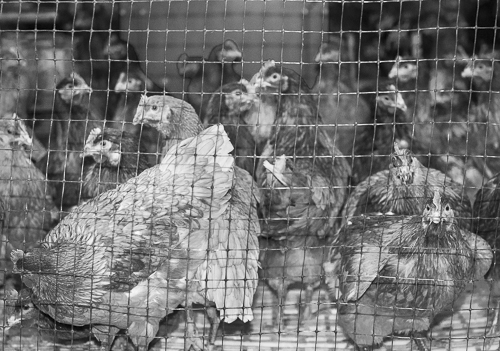Going from the town of Orduña towards a place called Lendoño Beiti, which consisted of some scattered houses, we arrived at the Oilo Bide farm in order to visit the owner, Ainhoa Álava. She grew up on a farm and was used to domestic animals like horses, cows, and sheep. However, after having visited an agricultural fair in Barcelona in 2007, she decided to start raising snails.
At first, we followed her to a gigantic shoebox-shaped enclosure consisting of a metal framework covered by a translucent, waterproof, and green mesh. Rows of horizontal metal bars supported hanging file folders made of some kind of fabric, while tall grass was growing everywhere else. The snails, of which there were two types, were mainly residing on the hanging file folders where we could only see their exquisitely made snail shells. However, some of the snails were also residing on horizontal metal bars where they were fed a mixture of organic cereals. Some of the snails’ heads with their characteristic tentacles were outside the shells.
According to Ainhoa, the snails never escape and she doesn’t need to look after them daily. Instead, her hens need daily visits, else the hen-house will be a mess after a short time. In addition to feeding the snails and letting them stay in benign surroundings, they are sprayed with water mist every evening.
At night, the snails exit their shells and Ainhoa sometimes receive calls from families with children who want to see the translucent snails, purportedly a beautiful sight.
Although snails are hermaphrodites, they must mate with another snail of the same species before they can lay eggs. They start laying eggs in March at the start of spring and they are harvested in October, meaning that there were only a few left at our visit.
Like all varieties of raising animals, a lot more can be said. If you want to know more, these sites may be of interest: The living world of Molluscs and Heliciculture (wikipedia). Note that snail farming is called heliciculture because the snail shells have helical shapes.
Having visited the snails, Ainhoa led us the the chicken house where about 3000 Lohmann Brown chickens were staying. These chickens are known for their adaptability to various climates and that they recover more or less quickly if they get ill. All of them were inside a big building during our visit, but they would be let to go outside in a few weeks. She told my guide that they were young and they needed some time to learn where they should lay eggs. actually, the chicken house was built in 2011 and the raising of chickens is done by a combination of maintaining traditions and by means of high technology.
The chickens are growing slowly at their natural pace and they are only given organic feed. Likewise, they are not induced to lay more eggs than what comes natural to them. Only natural light is used such that they can follow natural rhythms of day and night.
The care of the chickens and the quality of the eggs are certified a Basque organization called Eneek.
Ainhoa often goes to fairs to show her products as can be seen on her company’s profile on facebook.

